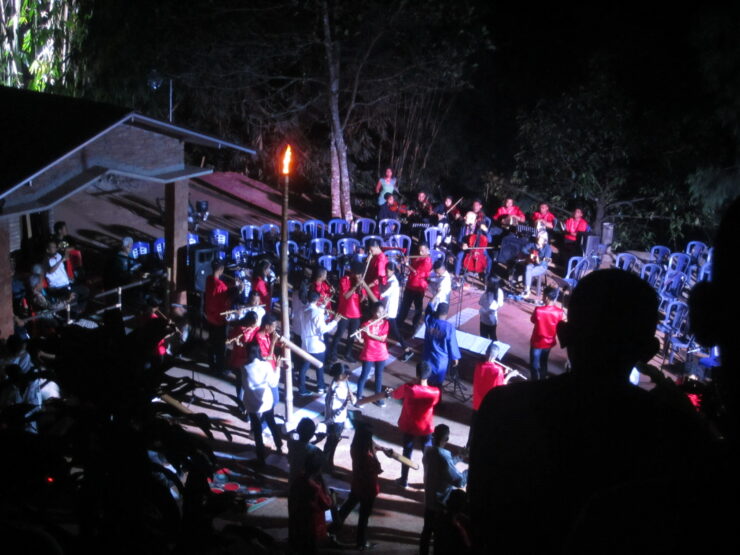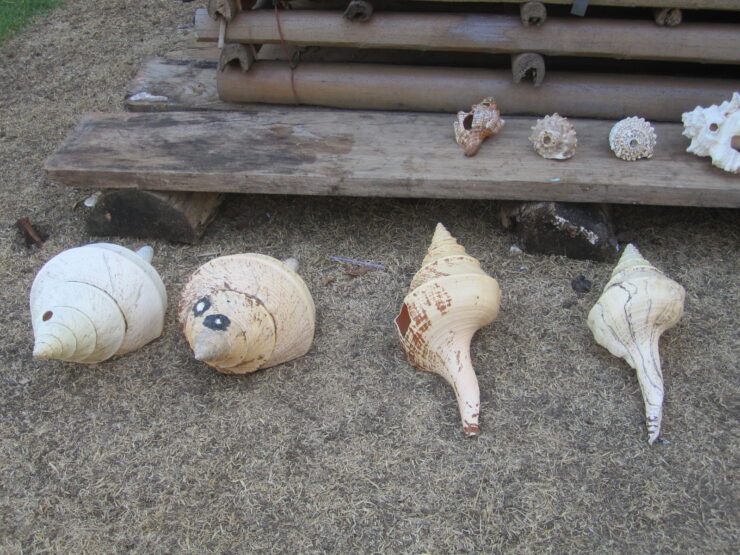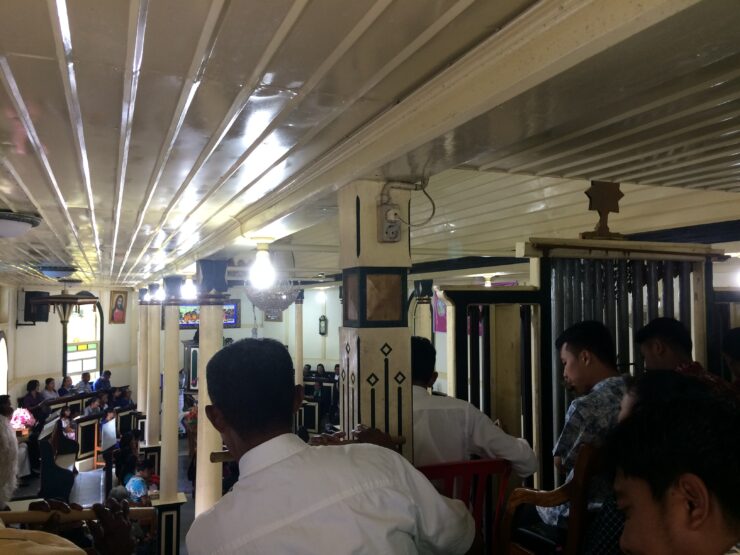Jip Lensink
In the first weeks of my stay in Ambon (the capital of the Moluccas, Indonesia), me and my friend Mark climb the slippery mountain road in the remaining rays of sunlight as the day comes to an end. The simmering sound of the motorcycle we are sitting on judges the steepness of this terrain amidst valleys of bright, green trees. We smell the pyres of fire burning garbage, we hear the birds, we taste the twilight fog and we see the sea surrounding this island. We feel fresh and free. Passing small houses, colorful villages, white churches and large families, gradually our journey becomes higher, darker and colder. We cross a narrow bridge made of old sagging planks and turn right into a sandy path that leads to the most spacious and pretty view over Ambon Manise. We are in a place called Tuni. In the dense darkness I descend the stairs and arrive at the round, dry, brown compound in front of the brick house owned by the musician who lives here. He sits on a tree trunk, I sit on a red plastic chair. There is no light. The absolute silence is only interrupted by zooming insects, barking dogs and our own voices. It is as if we are alone in the world. Two boys approach us, each with a bamboo flute in their hands. In this moisty, tranquil atmosphere they play for me.
In the last weeks of my fieldwork, I again find myself on the back of a motorcycle. This time we almost fly through the mountains and jungle, avoiding holes and bumps in the road. Halfway me and composer Barce stop at a lonesome stall to buy a plastic bottle full with green fuel to fill up the tank. Then we continue our way. In a small group we sit in the green garden of another musician. From our cheap chairs and bamboo benches we look out over the village Hutumuri, which at its edges is protected by the deep blue of infinite water and the light grey of sharp, looming cliffs. The man next to me is old and active. He runs, plays, moves and smiles to the point that his few black teeth are openly visible. His young wife and sons help to carry the instruments from the house to the grass. In a long row, from left to right, from very big to very tiny, they are laid down: the conch shells from the Moluccan sea. This is the traditional tahuri, an indigenous wind instrument. A group of children joins us, picking up the shells of various sizes, carefully holding the circular forms in their hands. On the sign of the musician, they take a deep breath, place their lips around the single hole on top and blow their round cheeks full of air. The hollow, echoing sounds are carried away by the wind, into the night.
For a religious studies scholar who is researching music, these two moments were connected in their perfect actualization of my anthropological imagination. Sitting in the inexplicable vastness of nature, amidst darkness, silence and kindness, I learnt about Moluccan music.
The two boys who gave a demonstration of the sounds that characterize Moluccan traditional music were playing the suling. The suling bears resemblance to the traverse flute, but is made of bamboo, has a slightly different fingering, and a relatively small range of tones. Interestingly, this instrument originated in a church context, having been introduced by the missionary Josef Kam to accompany congregational singing. Considering the impossibility of installing organs everywhere, Kam made use of the natural abundance of bamboo in the Moluccas to create a local diatonic instrument that could play Western Calvinist church songs. Since the beginning of the 19th century, the suling has by far been the longest used instrument in the Moluccan Protestant church (GPM), which only changed when the trumpet slowly took over this position from the 70s onward. Nowadays, the keyboard is the most popular church instrument, recognized by its echoing synthesizer sound backed up by standardized beats and drum rhythms.
In comparison to the rise in popularity of brass and electronic instruments, resulting in a more energetic, busy and loud religious soundscape, the suling is associated with a tranquil atmosphere created by slow, emotional, inspirational music with dominant tones, mainly preferred by older generations of congregants. To increase interest and regenerate the playing of this traditional instrument among younger people, initiatives have started by bringing the suling to a broader, public context. An example is the Moluccan Bamboo Orchestra, created by the musician whom I sat together with in front of his house in Tuni, Rence Alfons. His orchestra currently consists of more than sixty people, mostly children and young adults. They play pop, local, international, religious and classical music. In November 2019, I attended one of their open air concerts in an amphitheater made of sand, listening to their musical story about the present world, environmental problems and hope. The assemblage of Dutch-Moluccan musicians and suling players coming from all layers of society, of indigenous instruments and Western ones, and of traditional music and an ultimate modern composition resulted in a world-class performance. This assemblage on a unique place in a beautiful corner of the world resulted in artistic and Moluccan pride. The orchestra taught me how traditional Moluccan music can be modern and the other way around. Both conceptions are shaped in relation to each other and embedded in local and global musical realities.

Tahuri means ‘sound of the earth’ and ‘gathering’. Originally, the ethnic instrument is related to adat rituals. Adat refers to customary usage which has been handed down by the ancestors and which is passed on from generation to generation. The tahuri is a symbol of summoning and signaling and is connected to the calling of ancestral spirits. The musician in Hutumuri whom I spoke to, Carolis Elias Horhoruw, teaches more than sixty children how to play the instrument, hereby preserving this musical tradition. When the children enter the group, they have to run the hill next to the musician’s house up to ten times. While standing halfway himself, he listens to their breathing. On this basis he judges which tone, and thus which tahuri, a child can play: for a large conch shell stamina and muscles are needed! Besides ritual ceremonies and village events, since recent times the tahuri players also perform in church.

As a musical lens, the suling and tahuri make clear two developments in contemporary Moluccan society which are connected by the idea of what I have termed ‘the Moluccan traditional’. While the suling originally is a church instrument, introduced by a foreign missionary and diatonically scaled, and the tahuri is an ethnic, ancestral adat instrument, both are called traditional Moluccan music. Moreover, a variety of types of music are played by both instruments, showing that ‘traditional’ as an adjective is much more open and flexible than associations we might have regarding the term in opposition to modernity or aligning with conservatism. The Moluccas have a centuries-long history of musical hybridization and intercultural religious contact. For Moluccans, therefore, ‘traditional’ draws on local and ethnic culture, but is broader than that. Cultural forms can enter from outside, becoming incorporated in and changing ‘Moluccanness’. Through the ancestral lineage, a diversity of customs and values comes to be seen as part of the soul of Moluccan culture, forming communal identity – not in a static, but in a dynamic way. Based on this openness and flexibility, the Moluccan traditional is conducive to grasp the possibility of mixing: pasts and presents, ethnic and modern, local and global can come together in the historical process by which something becomes perceived as traditional.
The first development in which the Moluccan traditional is constructed is theology. In a postcolonial response to address the Dutch-Calvinist influence in the Moluccan Protestant Church (GPM), Moluccan theologians are currently occupied with developing so-called contextual theology. Moluccan theology aims at the contextualization of Christianity in Moluccan culture; Moluccan identity forms the framework for theologizing. Moluccan contextual theology is encompassed in the second development, which is a revived political focus on ethnicity. In current times of globalization, a feeling for the need of preservation of Moluccan cultural identity has arisen among politicians, theologians, church leaders, musicians and others. This ambition of preservation, innovation and regeneration is increasingly being voiced through the vocabularies of a heritage regime, whereby a construction of the Moluccan traditional is generally called ‘heritage’ – both in a religious and in a popular context.
The tahuri and suling are examples of the contextualization and regeneration of traditional Moluccan music: the ethnic revival stimulates the use of traditional instruments at schools, during political events, in the tourist industry and among music groups; and the church is a new context in which traditional instruments are popularized. Music is one aspect within contextual theology, propagated by the recently passed away musician and theologian Christian Izaac Tamaela. Tamaela taught future pastors how to transpose traditional Moluccan music, originally related to adat matters, to the church. Hence, instruments such as the tahuri enter the GPM through a contextual process, while the suling moves out of church to other contexts – and in this regenerating and broadening effort is in turn revived in a religious setting as well.
In practice, the implementation and reception of the theological contextualization of church music is rather complicated. A small group of congregants firmly disapproves of traditional church music, because of either a perceived mismatch with people’s modern life styles, or the stance that traditional music historically has been prohibited in church due to its entanglements with ancestor worship. Another small group firmly approves of the contextual approach on the intended theological level, being able to theologize through one’s own music and experiencing belief from Moluccan cultural identity. However, the majority of the congregants enjoys traditional church music as one of the ways to accompany worship. In so doing, they do not theologize music on the basis of a contextual perspective which links culture and religion, but see it as an effort to preserve Moluccan musical heritage. Interestingly, the discourse of heritage preservation is safer, because theologically the spaces of culture and religion stay separate: people do not start believing in a different way through their cultural identity, but appreciate their cultural identity in church. Since missionization, namely, contextualization has been happening from below. Christianity moved from one place to a different context, entangling Moluccan culture and Calvinism. Whereas the novity in Moluccan theology is a consciously formulated contextual connection between culture and religion, most congregants do not think with these terms on a theological level. As de facto the spheres have long been related, traditional church music is often not experienced as the outcome of a new a theological merging of the cultural and religious sphere, but taken as an appreciation of Moluccan musical heritage. Exactly because these spheres are practically related, for many congregants it is of vital importance to not cross the boundaries theologically, which would lead to perceived feelings of damage to both people’s Christianity and cultural adat system.
In order to implement traditional church music as a theological project, to that end it is important to take into account people’s contextual conceptions of the cultural and religious sphere – and their boundaries and relations. Also, it has to be asked what role music plays in this constellation. From fieldwork conversations I had with many Moluccan Christians, preferences of music, singing style, and song texts in church appeared to be part of congregants’ formation of a religious identity. When, where and how people grow up with which kind of church music significantly contributes to the creation of religious subjectivity and sensibility. As a materiality of sound, music becomes embodied, shaping religious experience and offering a perceived suitable connection between music and the religious sphere.
The moment of awareness of the intriguing formative efficacy of music was a personal experience in a beautiful tiny church in the village Soya. A pure and happy feeling of awe arose the moment I crossed the threshold. The round shapes of the roof and the windows, the light entering the space, and the resigned silence descending upon me; I felt peaceful. Behind me I heard the high, sharp sounds of the many suling flutes, played by younger and older musicians positioned on the open balcony in the back of the church, blowing the tones over the heads of the congregants. I smelled the old wood. The acoustics, the quality and the place, the power and volume of our chanting, the solemnity and the tranquility – everything was right. I began to reflect on why this happened to me in this particular situation. A network of words, music and atmosphere resulted in a spiritual feeling inside me, not in a religious sense per se, however definitely in a sense of love and beauty. I realized that perhaps the music and songs came the closest to what my mind and body remembered from attending church (although seldomly) in the Netherlands as a child. I also realized that this personal context determines the core of religiosity. Religious knowledge acquisition (including theology), religious memories and religious upbringing are stored deep inside a person, connected to emotions and experiences. This personal experience made me aware that the theological implementation of traditional church music is a complicated process, as context is not a unidirectional nor unambiguous idea, and certainly not easy to change. While it is possible for Moluccan congregants to learn and speak about contextual theology as envisioned by theologians, and even enjoy it in service, the question remains whether and how it will touch and transform ways of religious thinking and feeling.

During my PhD research I will build on these insights and further focus on the materiality of music and song as one of the core formative powers of religious identity. Within the project ‘materializing the study of religious texts and textual practices’, supervised by dr. Katja Rakow, I will look at the role religious song texts and related embodied practices play in the formation of the religious identity of Moluccan Christians. With song texts as an important category of popular religious texts as well as being a medium for theological ideas, the project aims to further develop the field of material religion. Song texts are approached as both material objects and as scriptural sources. It is asked how the religious song texts are related to ‘classical’ sacred texts, how they become embodied and are engaged with, and how they are produced and authenticated in the ‘scriptural field’.
This blog is based on my Master thesis “Traditional Tunes Transformed: Resonances and Dissonances between Theology and Lived Religion in the Protestant Church on the Central Moluccas”. On my website jiplensink.nl/thesis you can find the audio-visual material connected to the research. Teaser: listen to the suling bambu demonstration of the two boys in the night – below the vignette called ‘wind’.
Jip Lensink recently obtained her degree from the research master Religious Studies (Utrecht University) and is currently working on her PhD under the supervision of dr. Katja Rakow.
